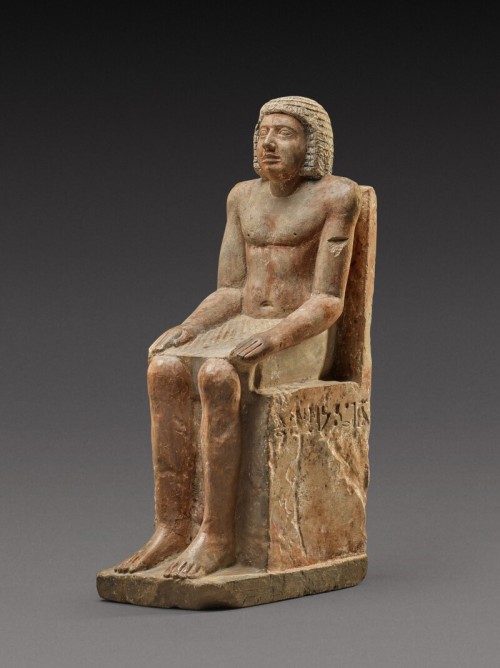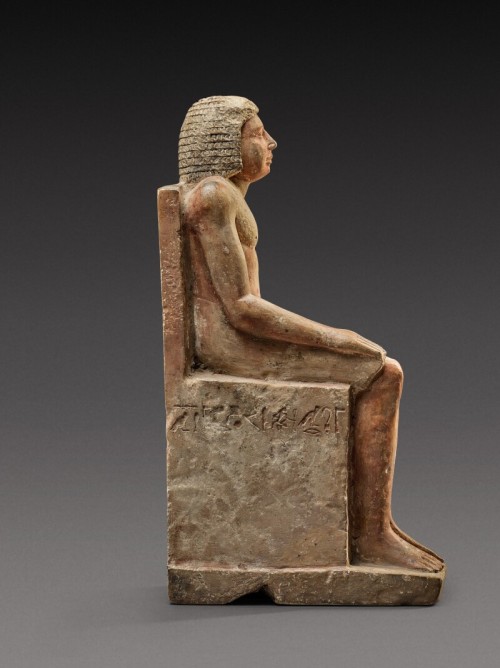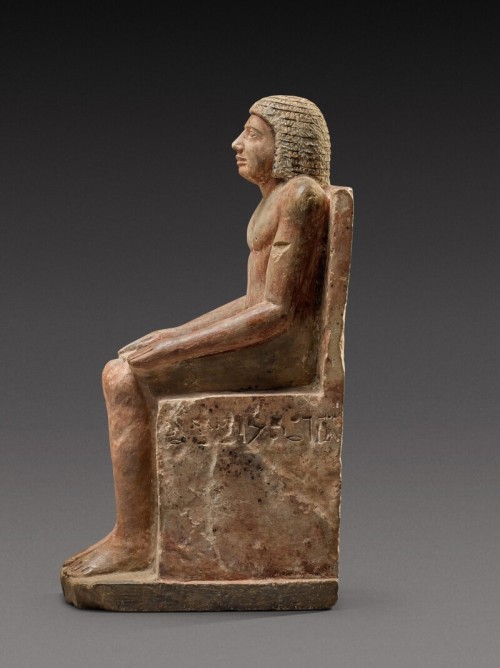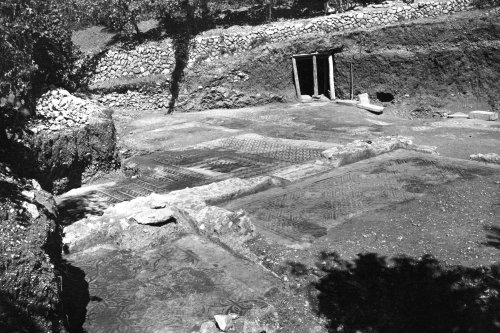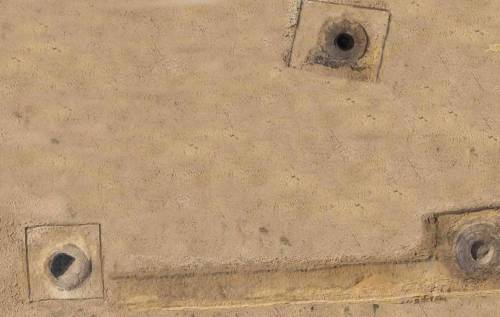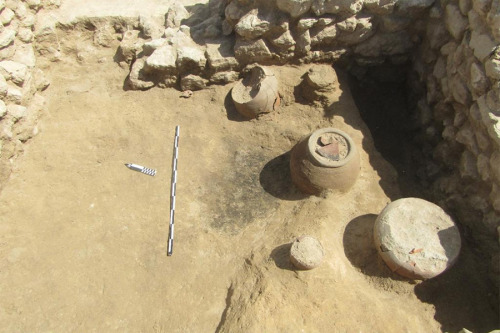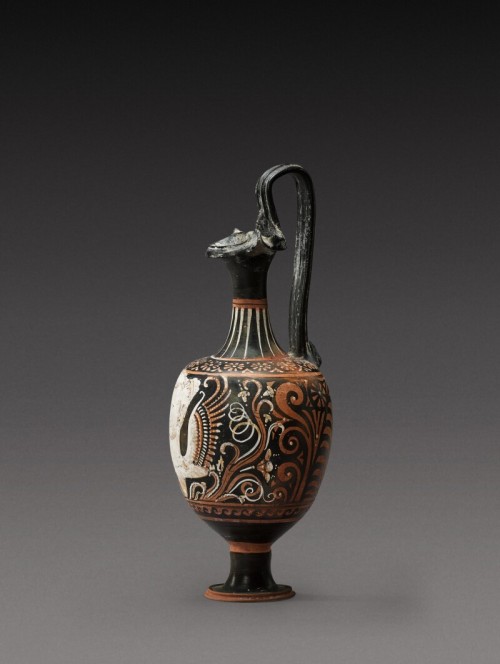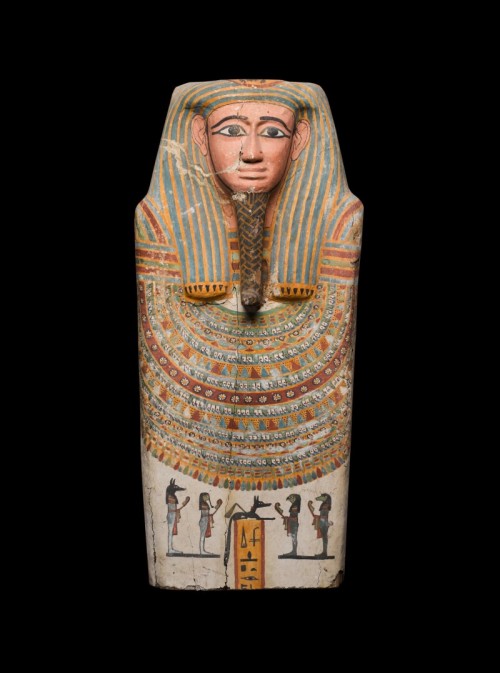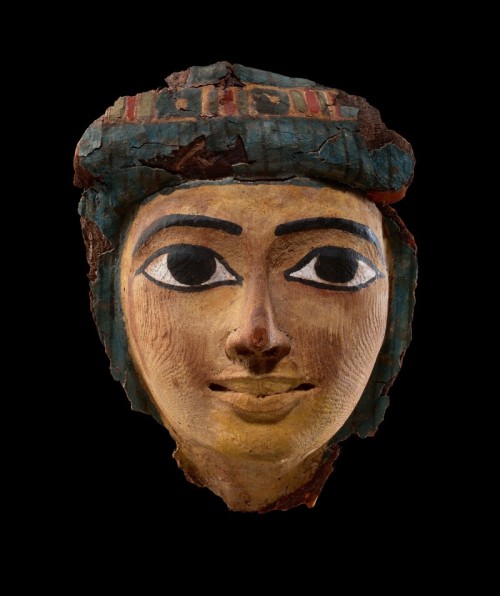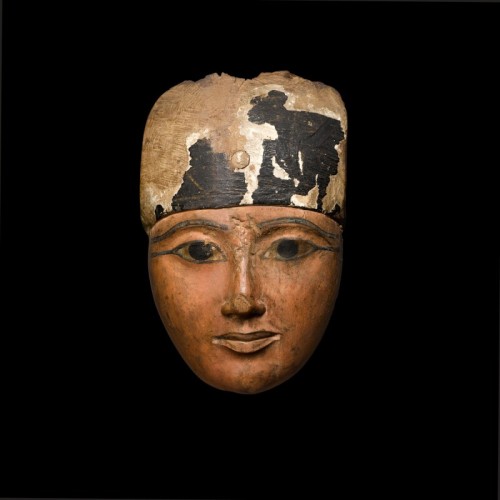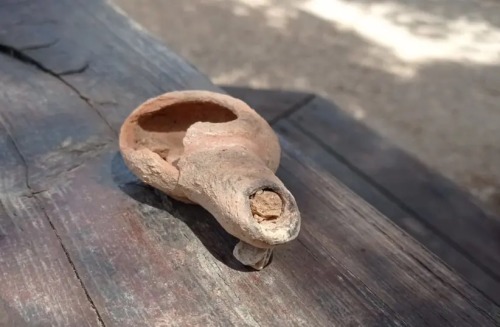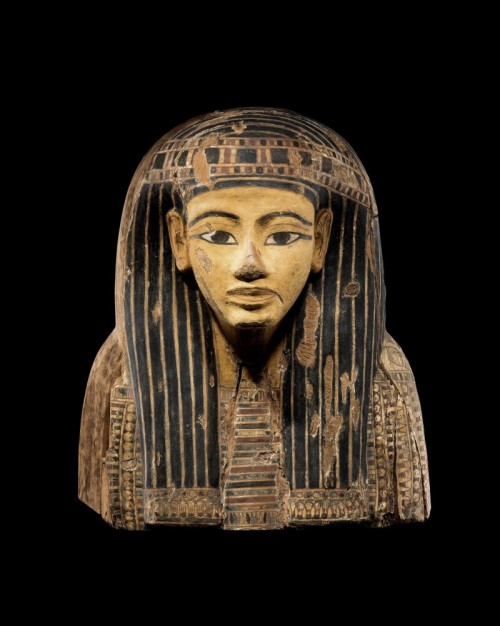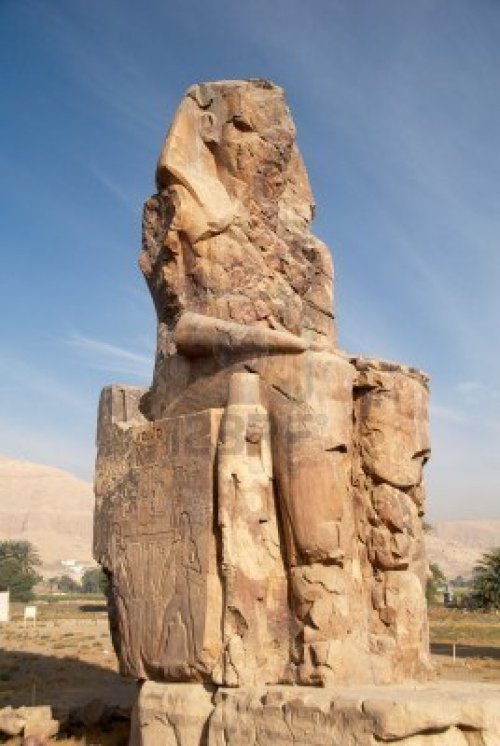#ancient artifacts
An Egyptian Polychrome Limestone Figure of Hem-Min
6th Dynasty, 2360-2195 B.C.
Inscribed “Treasurer of the God, Overseer of the Army, Overseer of the Prospectors, revered with the God,” seated on a high-backed chair inscribed on both sides with his names and titles, his hands resting on his knees, and wearing a short pleated kilt and wig of layered trapezoidal curls, his face with prominent chin, outlined lips, and slightly aquiline nose; remains of red pigment on the body and black pigment on the wig.
Height 48.3 cm.
Post link
Sixth-Century A.D. Mosaic Unearthed in Italy
A section of mosaic flooring from the 5th century palace of Ostrogoth king Theodoric has been discovered in Verona. The mosaic was found during installation of new gas pipes in the Montorio hamlet less than four miles from Verona’s historic town center.
Remains of an enormous country villa more than five acres in surface area have been turning up in Montorio since the 19th century. While there is no direct evidence that it was one Theodoric’s many palaces, the sheer size and scale strongly suggests it was a royal estate. If it wasn’t Theodoric’s palace, it must have belonged to someone of enormous wealth who was very close to him.
Theodoric was not technically a Roman emperor. He was three different varieties of king, though, starting in 475 A.D. as King of the Ostrogoths, then adding King of Italy in 493 and of the Visigoths in 511. By the time of his death in 526, Theodoric reigned over most of what had been the Western Roman Empire. He spent his childhood as a noble hostage at the imperial court in Constantinople and was educated there in the Eastern Roman tradition.
As ruler of a territory stretching from the Atlantic to the Danube, Theodoric embraced the ancient imperial trappings. He donned the purple, accepted the regalia of the Western Empire from Eastern Emperor Anastasius I Dicorus and allowed all Roman citizens in the kingdom to be governed by Roman judicial law. He instituted a vast program of reconstruction of Roman cities and infrastructure, restoring ancient aqueducts, baths, churches, the Aurelian walls of Rome and the defensive walls of a myriad other cities in Italy. He threw in a few new palaces for himself while he was at it, most famously in his capital of Ravenna, but also in other northern Italian cities like Verona.
The mosaic will remain in situ. It will be cleaned and documented in detail before being reburied. Some local residents have proposed covering it with plexiglass so the mosaic can still be seen, something that has been done already in Verona’s historic center, but this mosaic is in a terribly awkward position, trapped under networks of old pipes surrounded by homes, so it’s not a good candidate for display, unfortunately.
Post link
A Rare Shiva Linga Found in India
A group of workers laying the foundation for a house on a piece of land owned by a dairy farmer in Thuthipattu village near Ambur in Tirupattur unearthed a 500-year-old shiva linga.
A lingam sometimes referred to as linga or Shiva linga, is an abstract or aniconic representation of the Hindu god Shiva in Shaivism.
A team of officials from the Government Museum, Vellore, led by curator K. Saravanan, inspected the linga on Saturday and traced its origin to the later Vijayanagara era in the 16th Century. “We found a similar green stone lingam on a house plot at Arani [in Tiruvannamalai district] a decade-and-a-half ago,” Mr. Saravanan said.
To build a small concrete house for farmer S. Ramesh, workers were deepening a portion of the land to lay the foundation when one of them struck a stone idol at a depth of seven feet. Workers alerted the landlord, who informed the police and the village administrative officer.
The workers lifted the stone idol with a mechanised crane in the presence of revenue officials and the police. The shiva linga, which is two feet tall and 1.5 feet wide, has no damage to its structure.
Officials said that under the Indian Treasure Trove Act, 1878, anything found below a one-foot depth belongs to the government. Such treasure should be handed over to the district treasury, with the Collector being the sole guardian.
In this case, a report from the Government Museum, Vellore, will be sent to the Director of Museums, Chennai, and the Tirupattur Collector. Museum officials said the Collector would be requested to display the linga at Vellore Museum for students and others learn the rich past of the region.
The shiva linga, archaeologists said, would be around 500 years old and belonged to the Vijayanagara era because it was during that period, the region witnessed more temple constructions. Furthermore, most of the sculptures and idols in the region, including idols that adore the Jalakanteshwara temple, an ASI- protected monument in Vellore, belong to this period, and are made of green stones found in abundance along the Jawadhu Hills in Tiruvannamalai.
Like Sriperumbudur (the birthplace of Saint Ramanuja), the region along the Palar was a great centre for both Vaishnavites and Shaivaites. The green stone linga found near Ambur is a detachable one, another feature of the era. With the finding of the linga, the area has been earmarked for excavation, officials said.
Post link
Egypt Announces Discovery of Five Ancient Water Wells in North Sinai
An Egyptian archaeological mission working in the Tell El Kedwa region of North Sinai has discovered five water wells believed to be from the 13th century BC.
The Egyptian Antiquities Ministry said that wells were built before the reign of Seti I (1292-1190BC), but it did not give an exact date.
They are believed to have been a part of the expansive Horus Military Road, an ancient route that was used by pharaohs, the ministry said.
The wells were found outside the walls of the Tell El Kedwa fortress, one of several massive strongholds found in the area, which were used as military control points to protect Egypt’s eastern frontier and guard access to its northern regions.
The mission’s leader, Ramadan Helmy, said that four of the discovered wells were reportedly filled with sand to prevent the Persian army, which invaded Egypt in 525BC, from obtaining water.
The fifth well, which was unfilled, was a little more than three metres deep, the ministry’s said.
Inside it, the mission found 13 pottery rings and several clay pots dating back to the 26th dynasty of ancient Egypt (664–525BC), also known as the Saite period.
The fifth well was built in a haphazard manner, which was incongruent with the style of that period, Mr Helmy said.
The ministry said the mission’s excavations were part of a larger national project to develop the province of North Sinai, which contains prominent pharaonic sites that will soon be open to tourists.
Another archaeological team operating at the nearby Tell El Kedwa fortress discovered a large storage centre dating to the Saite period.
Inside the large chamber, the mission found a pile of clay pots. And within the walls of the fortress, the mission found the remains of kilns, also from the Saite period.
The kilns are were part of a large copper-smelting workshop, the ministry’s said. Copper shards were also found near the kilns.
The Horus Military Route was used during the old, middle and new kingdoms of ancient Egypt and was depicted in inscriptions at some of Egypt’s other prominent archaeological sites, including Luxor’s Karnak Temple.
At its peak, the route measured 220 kilometres and connected Egypt to Palestine.
By Kamal Tabikha.
Post link
Ancient Greek Pottery Workshop and Storage Facility Discovered in Alexandria
An Egyptian archaeological mission uncovered an Ancient Greek pottery workshop and a storage building at Tabet Al-Motaweh area to the west of Alexandria.
Mostafa Waziri, secretary-general of the Supreme Council of Antiquities, said a collection of kilns were discovered in the workshop, including two engraved in rocks, according to Ahram.
The first has a vaulted entrance through which workers passed to line up amphora in rows. The entrance is covered with clay and fragments.
Studies revealed the workshop was used throughout different periods. The northern side was used as a kiln for cement during the Byzantine time.
It was completely destroyed during the Middle Ages and converted into a cemetery. Inside one of the kilns a burial for a pregnant woman was uncovered.
Ayman Ashmawi, head of the Ancient Egyptian Antiquities Sector, said a storage was also unearthed containing a large collection of clay pots used for cooking.
The storage building comprised dorms for workers during the Ptolemaic era. It has 13 chambers, including one for religious rituals and prayers, another used as a kitchen, and a third for selling pots.
Inside the cooking pots bones of cattle and fish were found.
A large collection of Ptolemaic coins bearing the faces of Alexander the Great, deity Zeus and Queen Cleopatra were found on the floor of one of the chambers, while two large terracotta statues for deity Harpocrates and a yet unknown king in a very bad conservation condition were discovered in another chamber.
Hunting hooks and deity statues were found along with 100 catacombs.
Post link
A Roman Geometric Mosaic Panel
Circa 4th/5th Century A.D.
Centering a large lozenge design and composed of multi-colored tesserae.
121 x 201.5 x 2.5 cm
Sold: 44,100 GBP 12/2020
Post link
An Apulian Red-figured Oinochoe
Circa 330-310 B.C.
With high strap handle, the body painted with the winged head of a woman flanked by scrolling tendrils, the details in added red, yellow and white.
Height 45 cm.
Sold: 2,142 GBP 12/2020
Post link
A Greek Marble Figure of Aphrodite with Eros
Late 4th Century B.C.
Standing with the weight on her right leg, her right arm lowered and left elbow resting on a tree trunk, and wearing a chiton bound under the breasts and around the shoulders and himation draped around the lower body and left arm, winged Eros with crossed legs, leaning against her right leg; no restorations.
Height 45.7 cm.
Sold: 20,160 GBP 12/2020
Post link
A Roman Marble Candelabrum Finial
Circa 1st Century A.D.
With spiral fluted shaft and artichoke-like terminal with overlapping leaves.
Height 42 cm.
Sold: 6,930 GBP
Post link
The Upper Part of an Egyptian Polychrome Wood Coffin Cover
25th/26th Dynasty, 750-525 B.C.
Wearing a broad beaded and foliate collar, long braided beard with curled tip, and striped tripartite wig, the column of inscription in front surmounted by couchant Anubis, and flanked by the Four Sons of Horus.
Height 110 cm.
Sold: 16,380 GBP 12/2020
Post link
An Egyptian Polychrome Wood Mummy Mask
21st/22nd Dynasty, 1075-716 B.C.
The oval face with full outlined lips deeply indented at the corners, large wide-set eyes, and fragmentary striped blue wig with diadem.
Height 20.5 cm.
Post link
An Egyptian Polychrome Wood Mask
22nd/24th Dynasty, 944-716 B.C.
With broad oval face, bow-shaped mouth with finely outlined lips, straight nose, and almond-shaped eyes with long eyebrows and cosmetic lines painted in black, the remaining central portion of the wig with tenon for attachment.
Height 20.3 cm.
Post link
Ancient Samaritan Oil Lamp Discovered During Work on Mount Gerizim
The lamp was discovered while workers were clearing out an area around the stone bath from debris by hand.
A nearly completely intact clay oil lamp from 2,300 years ago was found near a stone bath during recent conservation work at the Mount Gerizim National Park.
“It is great to find something even after all those years of excavation,” said Netanel Elimelech, director of the park run by the Israel Nature and Parks Authority. “We found a lot of clay sherds lying around, but to find something complete with signs of its use is pretty nice. You can still see the black marks of burning from when the lamp was used. It throws you back (in time.)”
The archaeological complex on Mount Gerizim, located outside of Nablus, was excavated in the 1990s under the leadership of archaeologist Dr. Yitzhak Magen. Recently conservation and accessibility work has been undertaken by the Nature and Parks Authority and the Civil Administration.
The lamp was discovered while workers were clearing out an area around the stone bath from debris by hand, said Elimelech.
“We were clearing real close to the surface and the lamp just popped out,” he said.
The stone bath is believed to have been used for purification and cleansing by the Samaritans. Unlike a Jewish mikveh, the Samaritan bath is an actual element that, though heavy, can be moved.
The archaeological site on the Mount of Blessing at the top of Mount Gerizim spreads over 400 dunams. It includes remains from a large Samaritan city from the Persian-Hellenistic period which was built around a scared precinct. The precinct was surrounded by a well-fortified wall and in the center stood the Samaritan Temple. Remains of a large building containing dozens of rooms were previously excavated south of the sacred precinct. Within this structure is an olive press, a splendid residential building and shops.
The lamp, which is typical of its period, was found in the residential building. Other evidence of daily life such as plates, pots and vases, had also been previously excavated in the residence which archaeologists believe belonged to a family of wealthy priests, said Elimelech.
The Samaritans are mentioned in the Bible and view themselves as descendants of the Northern Israelite tribes of Ephraim, Menasseh and Levi, who survived the destruction of the Kingdom of Israel by the Assyrians in 722 BCE. Today members of the tiny sect who number in the hundreds live in two locations, on Mount Gerizim and in the Israeli city of Holon.
According to the Samaritan tradition, God chose Mount Gerizim for the location of the Temple, rather than Mount Moriah in Jerusalem, and it is here where God told Abraham to sacrifice Isaac.
By Judith Sudilovsky.
Post link
The Upper Part of an Egyptian Polychrome Wood Sarcophagus
21st/early 22nd Dynasty, circa 1075-950 B.C.
Wearing a broad collar, and striped tripartite wig with diadem and friezes of uraei at the ends of the lappets, the face with full outlined lips and long eyebrows and cosmetic lines, fine red lines delineating the folds of the upper lids.
Height 57 cm.
Post link
An Egyptian Encaustic on Wood Mummy Portrait of a Youth
Circa late 1st Century A.D.
Wearing a white tunic with red clavus and white mantle, his dark curly hair with a youthful ringlet beneath the right ear and surmounted by a foliate wreath.
31.4 by 15.2 cm.
Sold: 23,940 GBP 12/-2020
Post link
Colossus of Memnon - ancient Egyptian monument. Tho huge sculptures near the ruins of pharaoh’s Amenhotep III temple. 3400 year BC. Egypt, Luxor.
Post link
الملك الحِمْيَري ذمار علي يهبر. اليمن، أواخر القرن الثاني-أواخر القرن الثالث
Himyarite king Dhamar Ali Yahbur. Yemen, late 2nd-late 3rdC CE
Post link

I can see through you……… those deep looking eyes ❤
“Exhibition Sarcophagi - Brussels april 2016”
Source:https://t.co/efOKjaaYJc
#بلادي_الجميلة ❤ #مصر ❤


